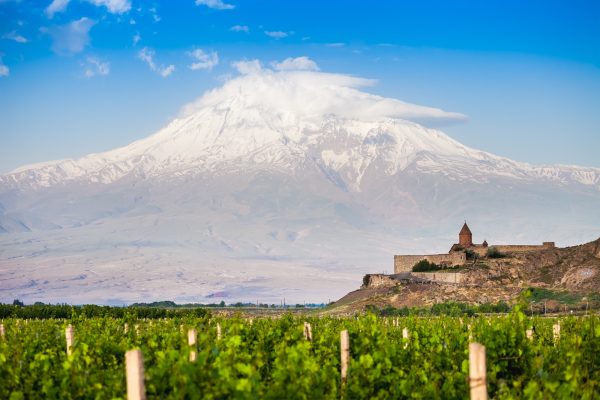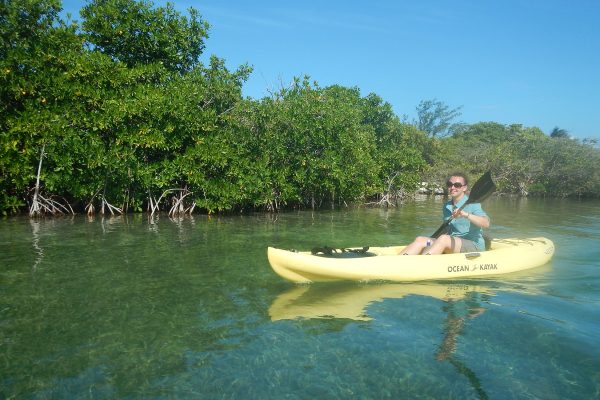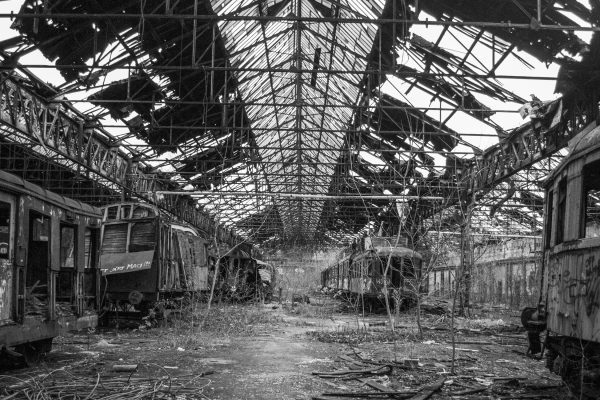Trip duration: 4 days | Approx cost: £400 | When: June – August
Doinit factor: The most remote part of the UK, with a fascinating history and spectacular scenery. You’ll be the envy of all your friends.
In a far corner of the United Kingdom, forty miles from the Western Isles, lies a speck of land that has caught the imagination of many. St Kilda supported a modest population, adapted to survive in such harsh and isolated conditions, for two millennia, but with the influx of modern world influence the population began to dwindle as religion, tourism, emigration and disease eventually eroded the sustainability of this fragile society. The 29th of August 1930 saw the final evacuation of its last inhabitants. Now the archipelago is recognised as both a natural and cultural UNESCO World Heritage Site, its significance on a par with sites like Machu Picchu in Peru.
Trying to get from London to St Kilda, or just the Outer Hebrides on a budget will mean you’re not in for the most comfortable of journeys. It’s going to be long and tiresome, but I say to myself; it will certainly be worth it! If money is less of an object, you can fly to a number of small airports on the Western Isles with FlyBe, changing at Glasgow, or even get the Caledonian sleeper train from London Euston Station to Fort William (or Glasgow) where you continue for the last few hours by coach. For me, it was on the 9pm overnight Mega Bus (tickets as little as £5) from London Victoria which gets me to Glasgow for 5am, and then a short wait for a connecting 7am Scottish CityLink couch to Uig (about £46 return) and finally a ferry to the village of Tarbert on Harris. Opting for the coaches is cheap, but long and boring, it’s not really until after I pass Glasgow that the amazing Scottish highland scenery begins to tantalise my mind. The mountains, valleys and lochs make for a lovely scenic ride, made slightly harder to appreciate after a sleepless night on the motorways of England.
It’s 2pm when I finally escape the confines of my coach seat at Uig, and here the ferry to Tarbert awaits (£5.70 single). Excited, my short adventure begins as I board the MV Hebrides, a roll-on roll-off ferry, similar though smaller than those you would cross the English channel in, but way more exciting simply due to where it’s heading, one of the UK’s most remote locations. As the sun shines, I go on deck to celebrate making it this far with a can of Tennent’s Lager as I watch the Isle of Skye disappear below the horizon. After an hour and forty minutes we arrive in Tarbert, Harris which will serve as my base of my stay.
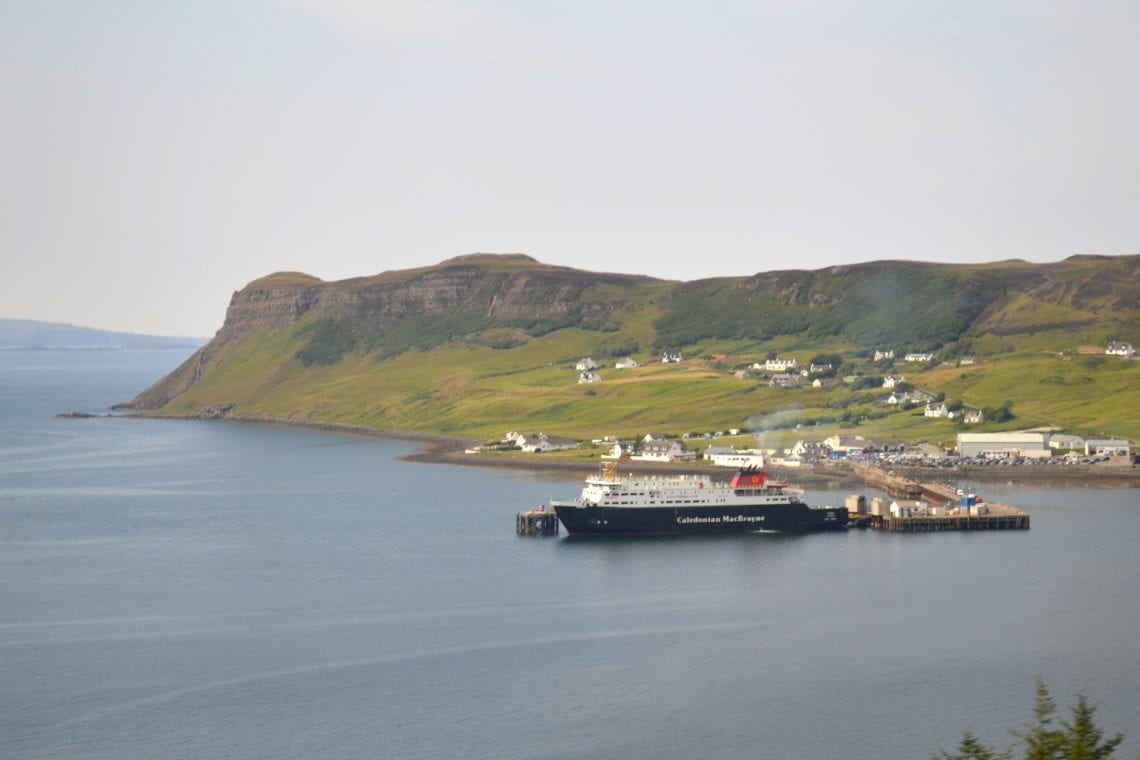
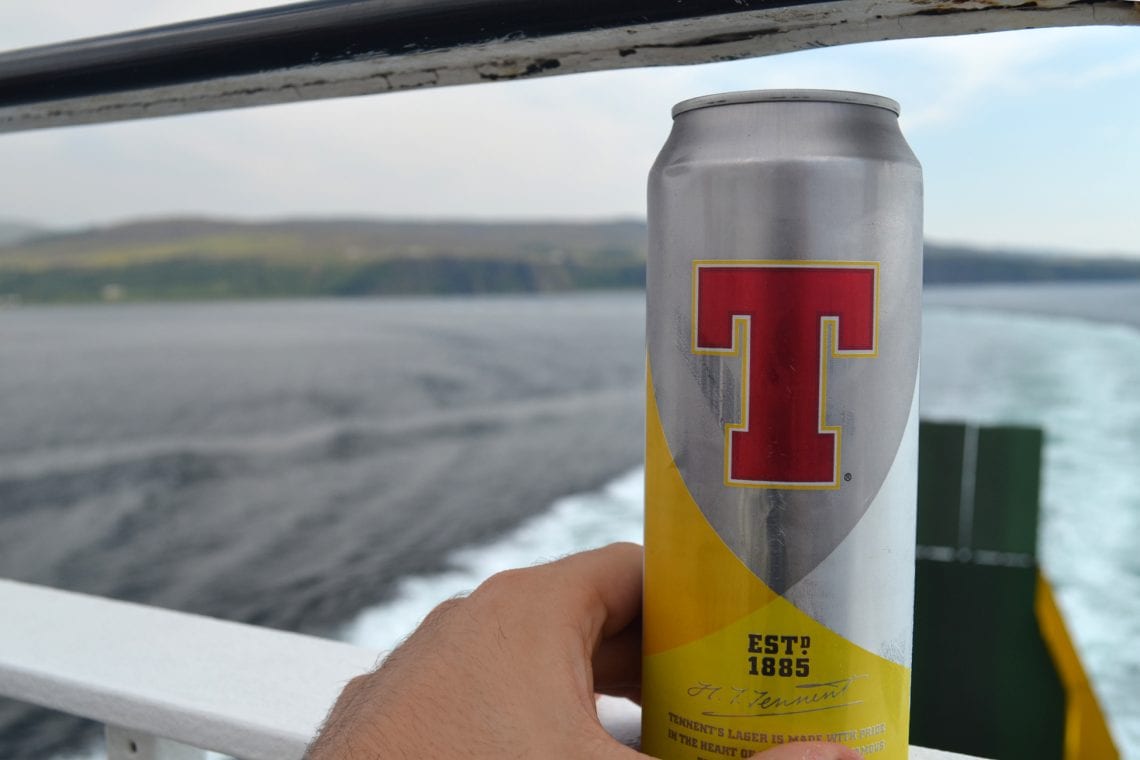
Above: Ferry waiting at Uig | May as well have a beer
Tarbert is a small and charming settlement, which acts as the capital and administrative area for Harris. You won’t find too much here; a few shops and couple of hotel bars. It’s located on a narrow strip (an istalus) of land with the sea on both sides, and steep hills which contain its spread. As I walk off the ferry, I recognise the tourist office at the end of the street. I head there in the hope of obtaining a basic bus timetable. It’s closed, so my second port of call is the Hebrides Hotel on the same road. I’m not checking in as I suspect this place may be a bit out of my budget, but the hotel bar looks inviting – I’m a great believer in a short break at the nearest pub presenting a solution to whatever situation you find yourself in.
I walk in and ask if they know when the bus leaves for Leverbrough (as that is where the boat to St Kilda will leave in the early morning), and I figured it’s best to wake up close by to where I’d be leaving. “Sorry, we’ve no buses on a Sunday,” I’m told by the young bartender. “Ah, taxis?” I ask. I sense a little hesitation when the bartender smiles and tells me she’ll check with her manager. It turns out Sunday may not have been the best day for my arrival. She disappears, so I figure I’ll treat myself to a pint and a late lunch or perhaps an early dinner of fish and chips. Just as I’ve placed my order the supervisor appears and informs me that they’ve the next best thing to an official taxi; she explains that only one real taxi firm operates on the island and they’re based an hour away in Stornoway, which incurs a substantial additional call out cost. They offer me the next best thing, and call a local man who sometimes offers to undertake taxi duties.
A pleasant half an hour’s ride starts to give me a feel for these islands. First, I begin to realise that they’re massive: looking at a map just doesn’t do this place justice, and I soon realise my backup plan of walking would have been foolish. Instead, I enjoy the ride as it takes me past wide deserted beaches, moors, highlands and lochs, occasionally passing a lone building or playing chicken with stubborn sheep on the narrow roads.
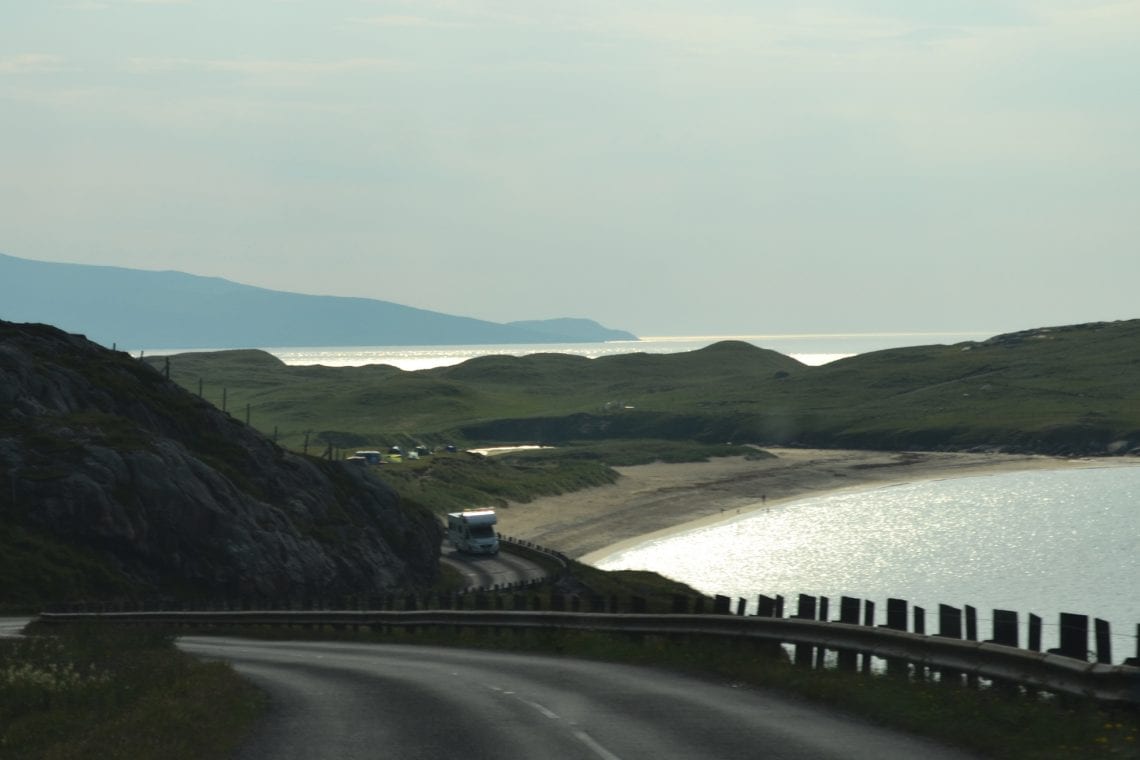
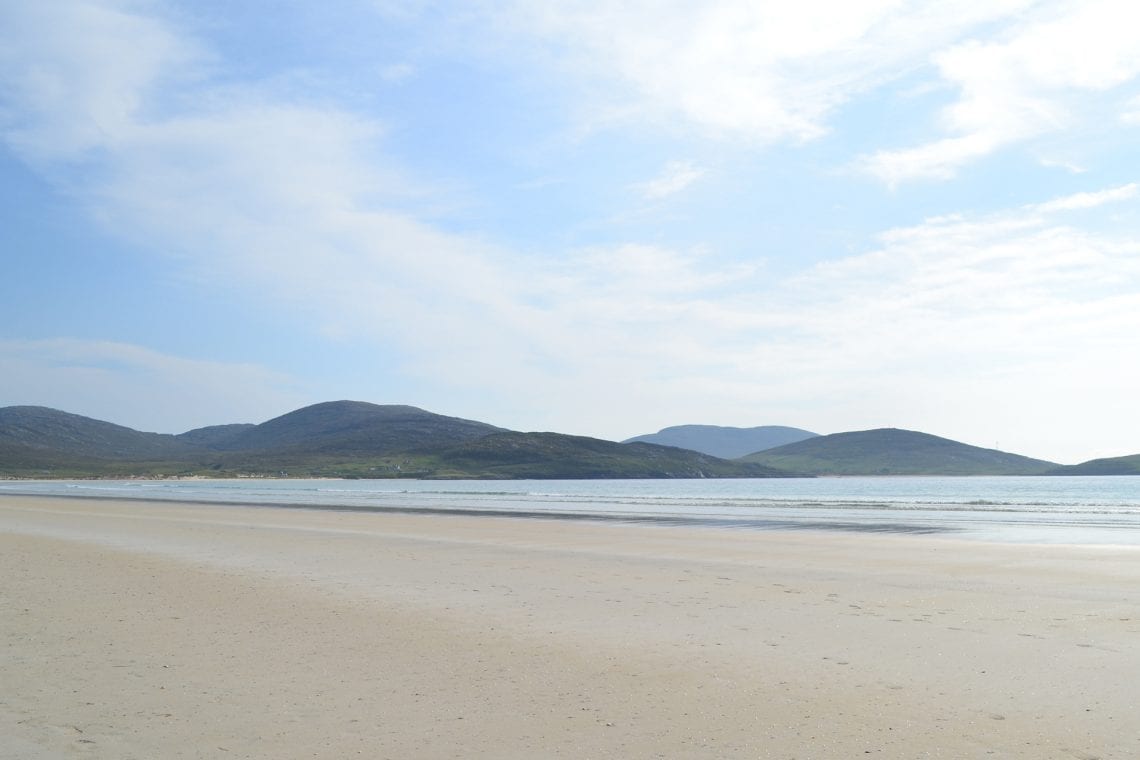
Above: Driving past some stunning white beaches on Harris
£30 lighter after my ride, I arrive at Leverbrough to be told there’s nothing open today, not that there is much there anyway. I‘m told I won’t find anything to kill time until the morning, but why kill time when it looks like time has stood still? Leverbrough is a lovely spread out village, with no person in sight, just a light breeze in the late afternoon and the evening sun reflecting off the coastline. My pre-arranged bunkhouse is hard to miss; a big red building with a large “BUNKHOUSE” sign on its side will be my home for the night. I’m eager to dump my bags and set off for a little wander to the small harbour where I will be setting off for St Kilda the next day. A few boats are moored in the nearby waters but the highlights are two stunning vessels moored close to each other, the bright red hulls of the Orca III and the Hirta are the unmistakable hallmark of Kilda Cruises, who I’ll be sailing with.
As the sun begins to set on this sleepy place I find myself on the porch of the Am Bothen Bunkhouse. It’s a pleasant summer’s evening but as the sun continues to disappear it also becomes noticeably cooler and time to put on a jumper. The rest of the evening is spent sipping on a couple of bottles of beer I picked up in the Hebrides Hotel Bar before turning in for my early morning.
Now I’m certainly not a morning person but today, waking at 5.30am, showering and making my coffee wasn’t at all a burden – I’m far too excited by the anticipation of my upcoming voyage to the edge of the world. Following a brisk walk towards the nearby harbour, where a few people were gathering, I’m approached by a man who seems to know who I am, he introduces himself as Angus; he runs Kilda cruises and captains the Orca III. A brief handshake and he explains the sea swell on St Kilda is much too high and that it won’t be possible to land today. An overwhelming sense of disappointment fills me, and I’m not really sure how to respond to Angus. After all, I’ve travelled up from London all this way, only to be told I won’t be sailing anywhere. Of course, at the time of booking Kilda Cruises strongly advised I allocate an extra day to my itinerary in case of such circumstances, but still I can’t help but feel disappointed. Angus tells me that we can try again tomorrow, though he didn’t sound too confident that tomorrow’s conditions would be any better. Perhaps tomorrow was down to luck, or maybe years of experience have taught him to limit expectations.
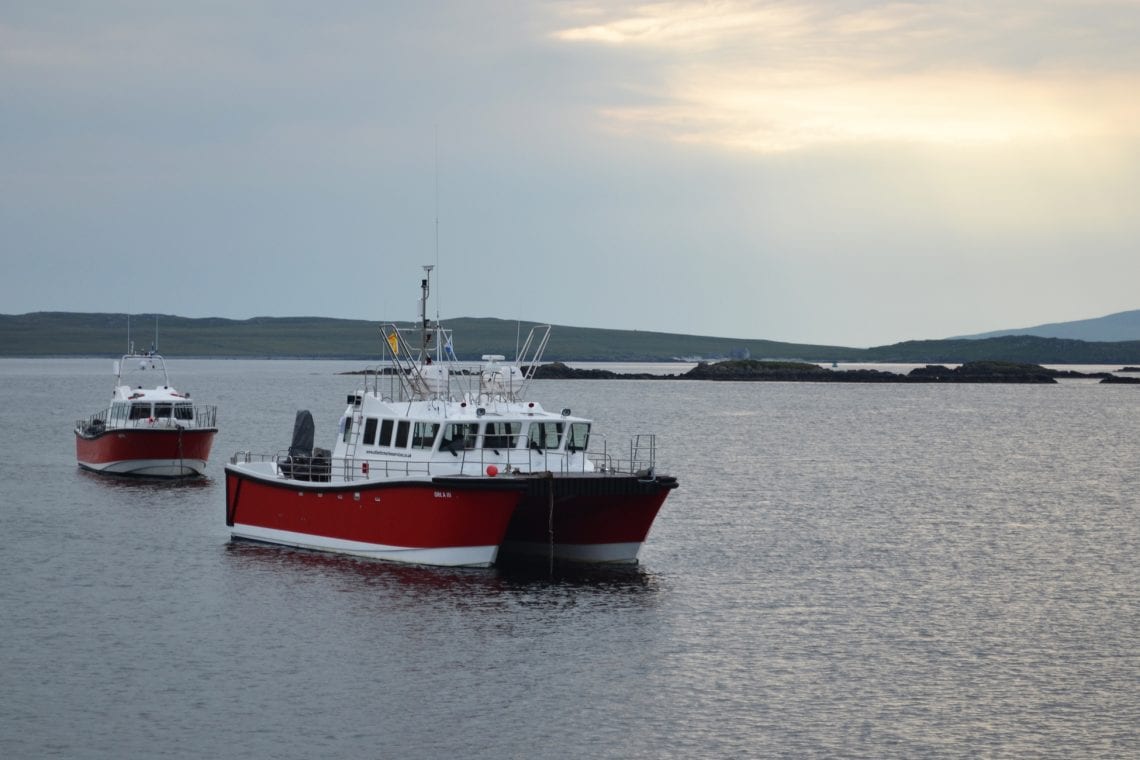
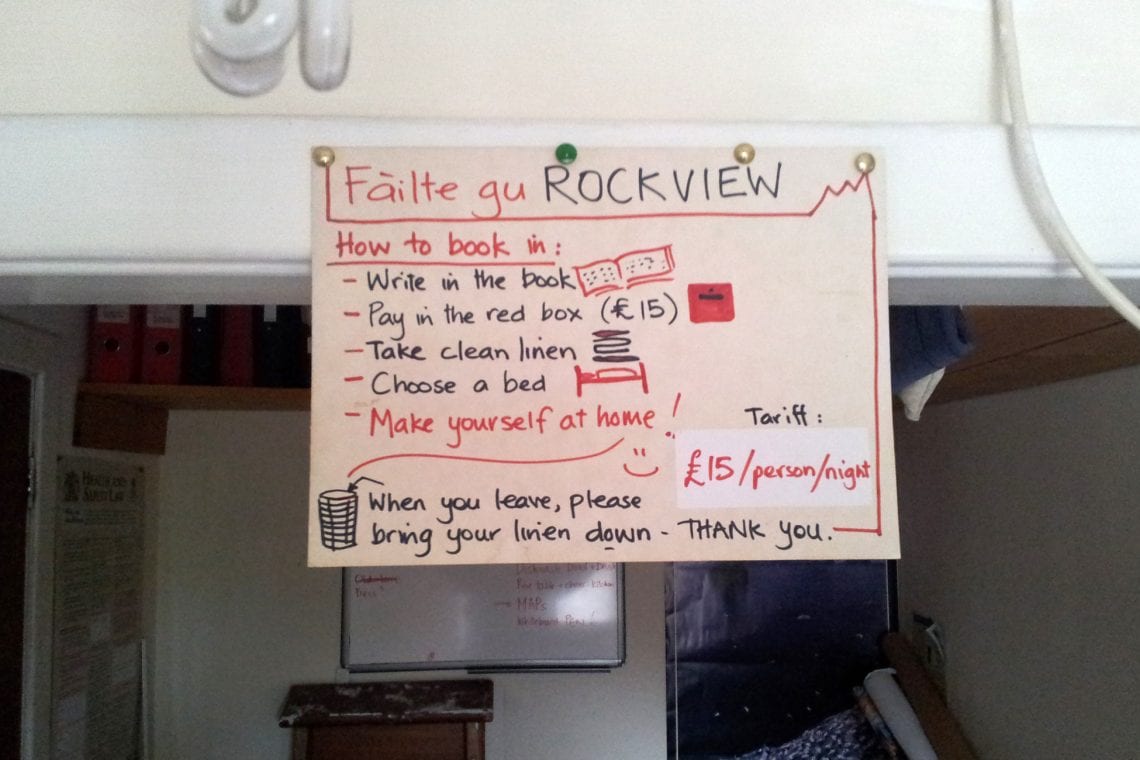
Above: Boats not going anywhere today | Sign greeting guests at the hostel
Angus kindly offers me a lift to Tarbert, where I’ll find my way to another bunkhouse, Rock View, which is pretty much a self-service affair. Punch in a code to let yourself in and drop the money in a small box left downstairs, it reminds me of my old student digs so I feel right at home. I have the place to myself but I won’t spend much time here as I want to explore. I’ve a few choices on how to proactively spend my day. Not too far is the Clisham, a 799 meter high mountain whose peak marks the Western Isles’ highest point, or perhaps I could rent a bicycle and head to the beaches of Harris – world renowned as some of the most stunning beaches on earth. I’d driven past Luskentyre Beach and from my ride it looked like a scene from a Caribbean holiday brochure, miles of flat white sands and turquoise waters hugged by green Scottish hills and moorland. It’s a tough choice but instead I opt to make this tomorrow’s back up plan.
For today I decide I’ll visit the Callanish Standing Stones and Stornoway, the capital of the Western Isles. First it’s a visit to the Tourist Office to formulate a travel plan. They explain to me the nature of the islands’ bus system. Essentially, coaches service the islands’ public transport needs; they run few and far between but provide the vital link connecting the settlements for many of the islanders. I’m told I’ll need to change coaches in what appears to be the middle of nowhere. Furthermore, timetables aren’t really printed to keep cost down, and if I miss a connection then it could be a very long wait or a long walk back to civilisation. I’m told to let the driver know my plans and he can drop me off and tell me where to head onwards, so I do just that. The fifty-seater coach races though the moorlands on narrow hilly roads like a giant rally car: these coach drivers clearly know the terrain and I’m sure they must enjoy ragging these massive vehicles around the empty roads. Miles and miles of barren, uninhabited landscape as far as the eye can see truly make an impression of unforgiving terrain should one be caught out, and it’s not long before a new found respect for this place is thrust upon me. Yes, the emptiness is strongly beautiful but it could well be deadly. The remoteness is occasionally broken up with scattered settlements and every so often with locals running from their front road to coach our bus, the reality seems to be local transport service offer close to a door-to-door service and will pick up and drop you anywhere along the route. After about forty minutes, I disembark to find another coach already waiting for me, and then it’s only another twenty minutes ride before I arrive at my first stop, the remarkable Callanish Standing Stones.I make my way up the path, conscious of the fact that the next bus leaves in forty minutes or it’s a two hour wait. While there’s no rush, I’m just not convinced that I could appreciate the forthcoming landmarks for that long. The standing stones come into sight, massive grey rocks vertically planted in the green grass. Dated to about 5000 years ago, they represent an ancient burial ground. Like Stonehenge, these monoliths are impressive, but unlike Stonehenge you can walk straight up with no restrictions.
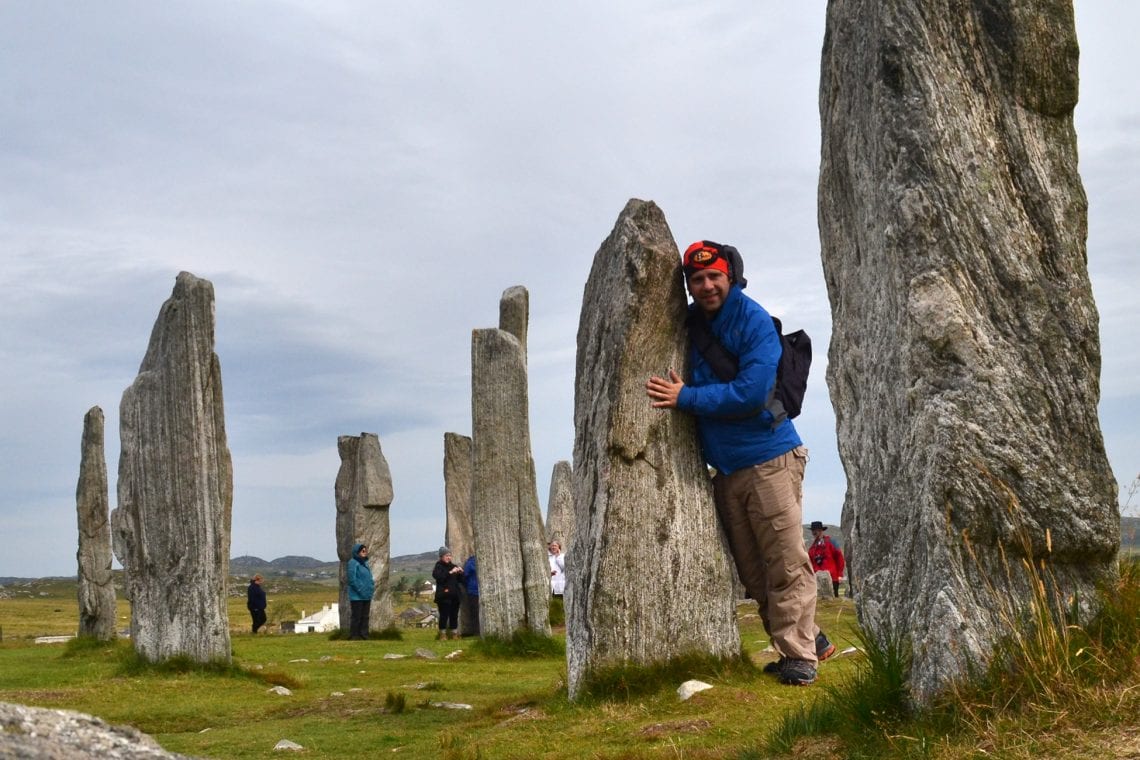
Above: Unlike Stonehenge you can really get up close to the Callanish Standing Stones
Impressed with my first replacement trip, I’ve almost forgotten my cancelled sailing as a coach takes me to the administrative capital of the Outer Hebrides, Stornoway. I arrive here and begin to explore on foot. Though the population is only around 9000, this is a bustling metropolis compared to the rest of the settlements I’ve seen so far. I quickly notice the abundance of pubs – perhaps an attempt to make up to the scarcity of them elsewhere! I note to myself it would be rude not to visit at least one before I leave town, but first I wander the streets and make my way to the neo-gothic Lews castle. Unfortunately, I can’t get as close as I’d like due to renovation work. Most of Stornoway can be easily covered on foot, it’s a modest town with a few recognisable high-street chain stores. Perhaps it’s the grey skies and the rain which contributes to my subdued mood here. For now it’s time to wait for the bus home – well, after a pint of course! It’s amazing how quickly the day slips away, and before I know it I’m back on an almost-full bus to Tarbert. The driver speeds across the barren landscapes of the Western Isles as I chat to a native Glaswegian who settled here over eight years ago.
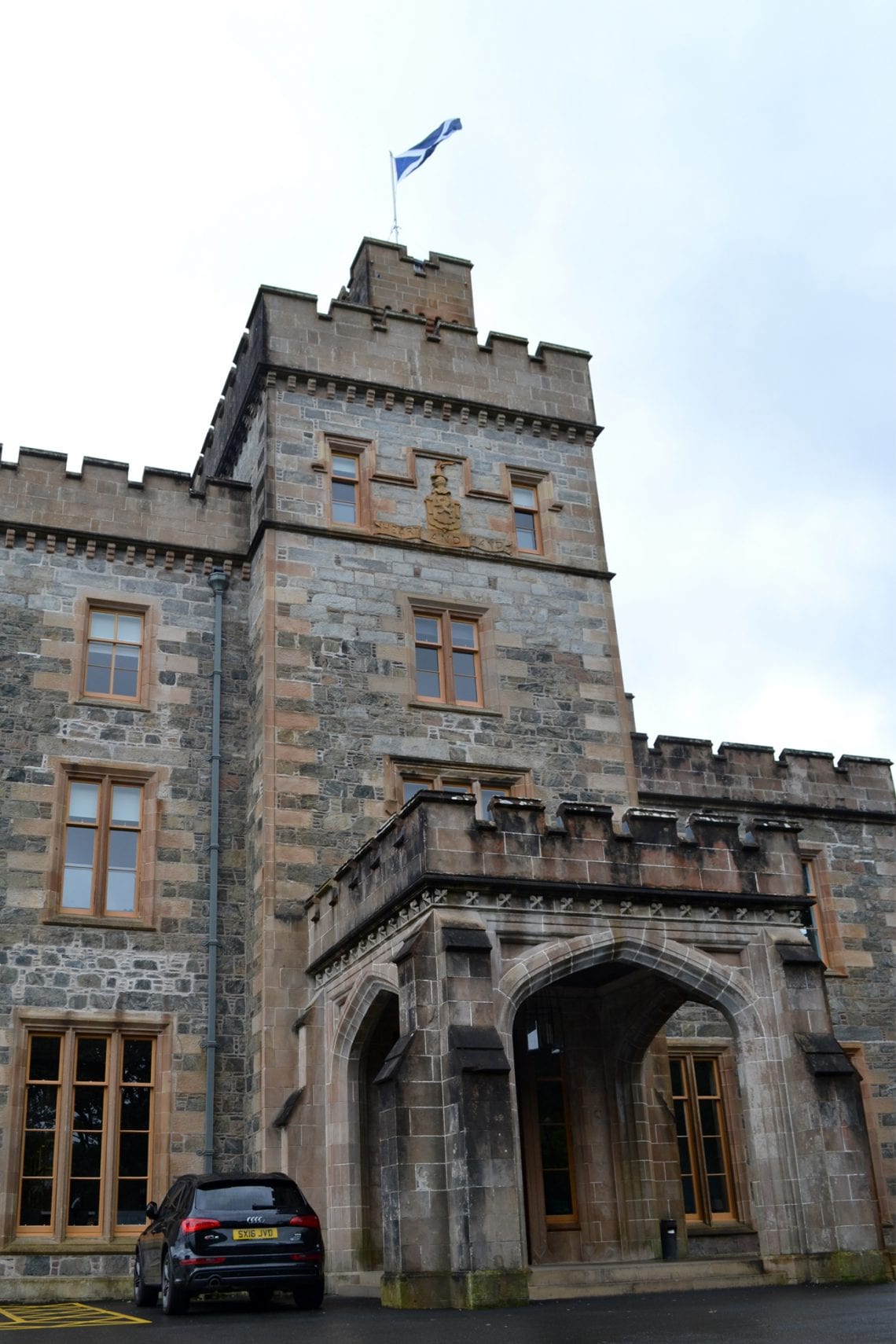
Above: Strolling around Stornoway | Lews Castle
Over dinner in the Harris Inn I think about tomorrow’s back up plan of climbing the Clisham, and then a ride to the beach, perhaps even braving a dip in the North Atlantic. At this point I’m excited by how tomorrow may turn out, and have nearly put St Kilda out of my mind when my mobile phone suddenly vibrates on the wooden table. It’s Angus, letting me know the sea conditions for the morning. It’s a yes: we are due to sail first thing! For a moment I feel a pang of disappointment as my planned alternative day won’t materialise, but this quickly passes. Angus kindly offers to pick me up from Tarbert as I’m on route back to Leverbrough, it’s much appreciated, even if pick up is at 6am.
Finally onward to St Kilda
The next morning I’m in Angus’s 4×4 with his young son Alex and crew mate Murdur as we head back to the harbour at Leverbrough. I see another Kilda Cruises crew preparing the sister vessel, the Hitra. I’m there before the rest of the passengers and while Angus, Alex and Murdur refuel and prepare the Orca III for sail I wonder what kind of people visit St Kilda, and why. Finally I’m called on board the newer of the two, the Orca III. She carries twelve passengers, is very modern and with the open bridge I’m fascinated by the vast array of monitor screens, radar, GPS and other instrumentation positioned upfront.

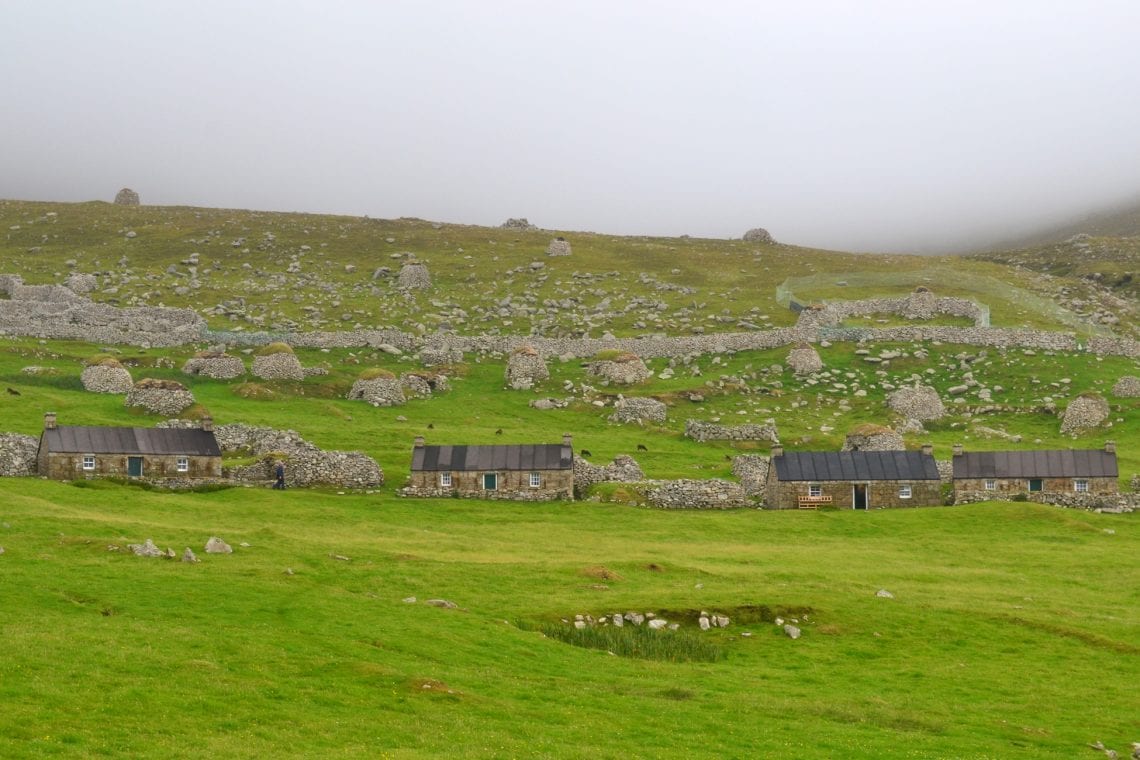
Above: Disembarking our boat it’s time to explore St Kilda
After an initial safety briefing, Angus takes his place on the captain’s seat, the engines roar into life, and we head for the open ocean. We’re allowed outside on the rear deck, providing we have our life jackets on. I’m joined on deck by a few middle-aged couples as well as a retired couple, and a family of bird enthusiasts. I’m the only solo traveller. It seems there’s no stereotype visitor to St Kilda, and the one thing we all have in common is that for whatever reason, this fascinating place has caught our imagination. Sailors often see a variety of wildlife from whales to puffins, but for this voyage we’re out of luck and all that’s abundant over the long two hour and forty minute trip are the dark clouds forming overhead; it seems the heavens could open up at any moment. I half expect a shout of ‘land ahoy’ when the island of Hitra appears on the horizon, but no such cry is made. We continue our approach into Village Bay, anchors drop and we prepare to disembark on to a small jetty via a small motor dinghy. I’m given a hand up, and we’re soon greeted by the island’s warden.
He explains that he’s one of three employees of the Scottish National Trust, his colleagues comprise an archaeologist and an ornithologist, in his words a ‘bird woman’. He describes himself as a general dogsbody, filling multiple roles from maintenance to clerk of the gift shop, which he’ll later open for us. He continues to explain that there are a number of Ministry of Defence contractors on the island who are best not disturbed. They share the island with a number of researchers and students who are here for the summer to study the unique species of found here on Soay and Boreray. The weather’s not looking good and the surrounding peaks are engulfed in cloud. The warden points in various directions suggesting where to go and where to stay away from. He emphasises the dangers of getting lost or worse, falling off a cliff. Wished a good day, we set off to finally explore the island. On first impressions I think to myself, ‘this was not in the brochure’; blocks of green portacabins used by the MOD as barracks and offices, and a large ugly grey building disturbs the peace with what I assume to be the generator for the complex. It takes a few minutes to navigate past these modern monstrosities before a visitor can finally make eye contact with the old village buildings and wow, what a sight!
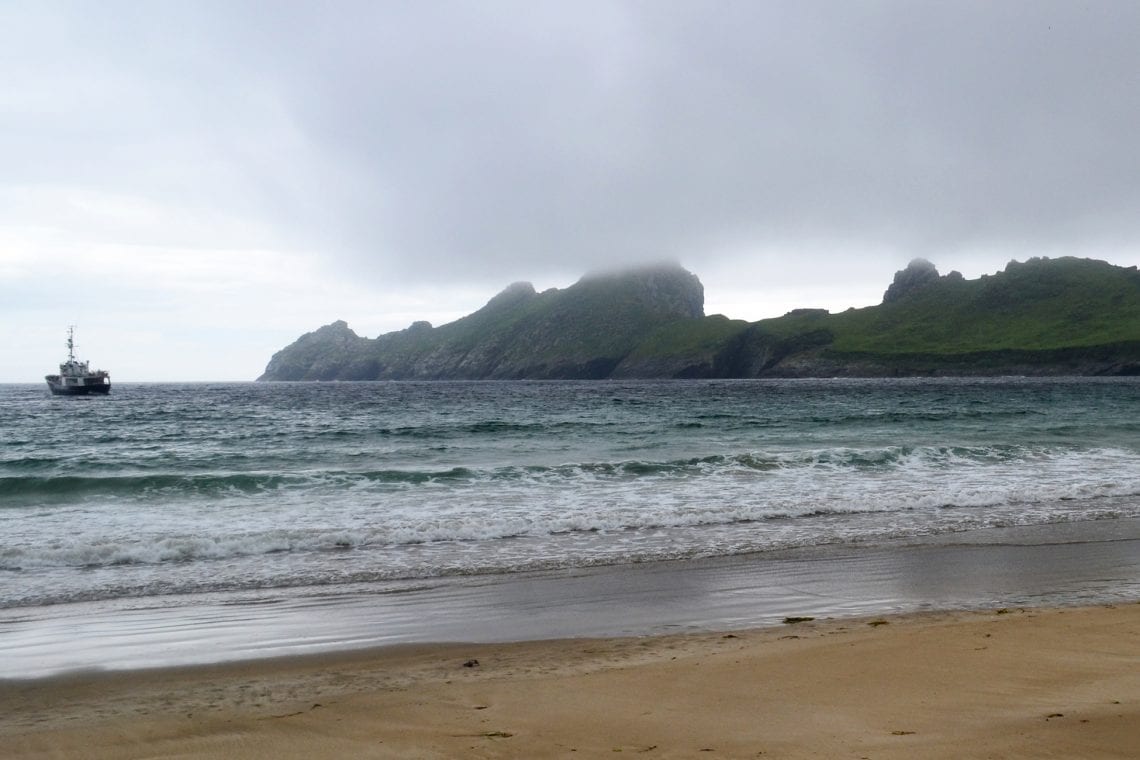
Above: Dramatic views form the beach
Instantly I forget about the modern structures behind me as I get lost in the atmosphere. A lone street with the ruined houses along one side that once stood inhabited. The first five houses have been restored and let to the researchers as accommodation. House number three has been converted into a small, elegant museum with much information, illustrations and artefacts. Many of my fellow day trippers have their packed lunches here, however I’m much too excited to be in such an astonishing place to sit inside, so after absorbing as much information as I can, I carry on along the village street. To my left is the bay, to my right is the single row of houses along the old village street, the backdrop to which are the steep hills, disappearing into the mists. Scattered all along landscape are cleits, small stone structures roofed with turf used for drying foodstuffs and keeping goods cool and dry.
I stroll along slowly along my path, entering these now roofless buildings to truly get a feel for how the islanders lived. Fittingly each ruined building has a piece of slate, no larger than a roof tile, on the ground resting against the wall with the name, age, and year of the last occupant. Names like Ewan Gilles and Rachel McDonald really bring to life that this isn’t just a ruin, but it was a home for someone, a home they were forced to leave
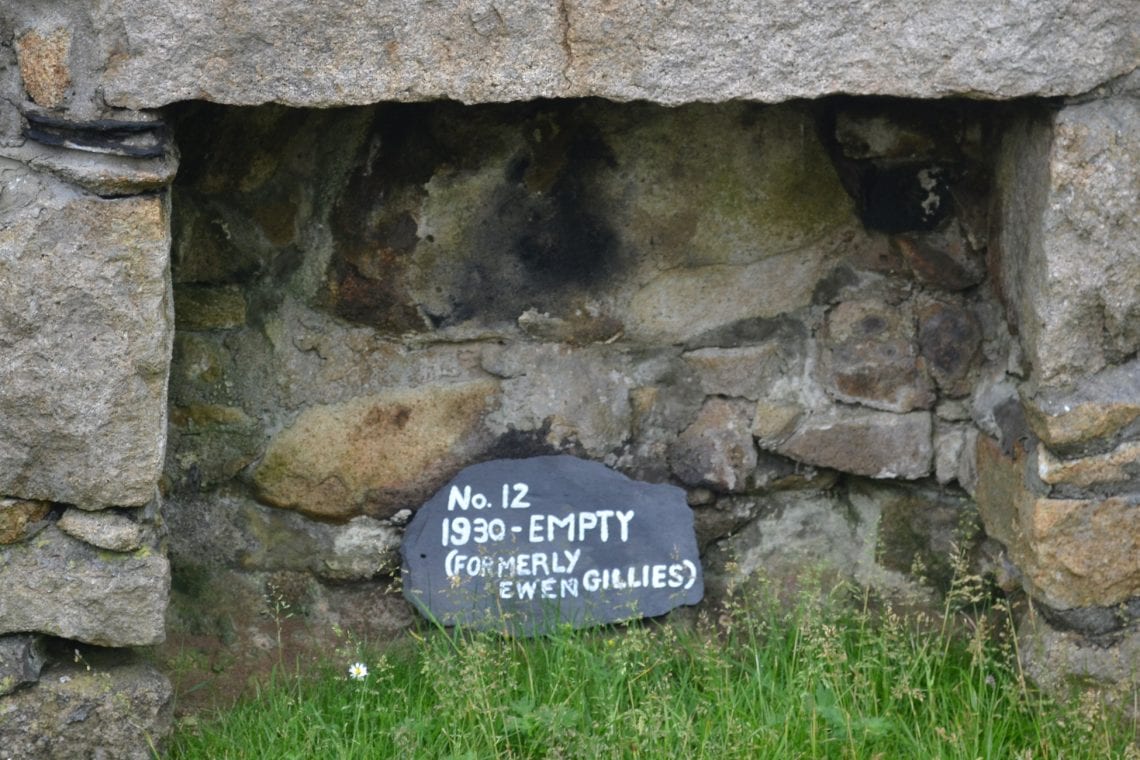

Above: Walking through the old village is one of the most remarkarble experiences of my life – you can’t help but imagine what it would have been like 100 years ago
Leaving the village behind I now follow a concrete track laid by the MOD uphill. It leads to a radar station positioned on one of the islands high points. I’m eager to reach a high point, or ideally the highest point on the island from where I’m sure the views must be amazing. I’d be able to see the village from high above and the sea stacks in the ocean miles way which make up this archipelago. Wishful thinking with the current weather conditions, I’d be lucky to see a metre in front me at a respectable altitude, but I’m not deterred. The walk is steep, and as I carry on upward I can see the village bay below, the grey buildings, the lush green grass with the slight turquoise ocean, fading into deep blue further along the horizon, even on such an abysmal day.
A few more vertical metres and I’m completely swallowed up in the low cloud, visibility is down to a few metres, and the village below me has now completed disappeared. It’s raining, windy and not at all pleasant as I persevere onward for another half-an-hour when suddenly, out of the white, grey buildings with domes and masts begin to emerge. It’s the unmanned radio stations on top of Hitra. They give this place a ghostly feel, and I half expect zombies to come at me. Though I can’t see it, I certainly feel that this is a very exposed area as the winds blast my body and sideways rain drops sting my face. Here the road ends, and under normal circumstances, if one were to continue to reach the islands highest peak, they’d have to walk off-track along some of the highest cliffs in the UK. With such bad visibility any attempt would be extremely unwise, so I reluctantly turn back down the road. With every downward step the conditions seem to improve: less rain, less wind and thirty minutes later the village comes back into sight.
I pass a flock of unique sheep, they’re much darker, and with larger horns then what I’d expect, but that’s as far as my analysis goes. Back at the village bay, it’s time for the mandatory photo opportunities as I carry on exploring every nook and cranny of the village – I even make it down to the sandy beach. This place seems to exert such presence that I think I could never tire of it: a dramatic landscape, amazing natural beauty and fascinating history as well as an important wildlife habitat.
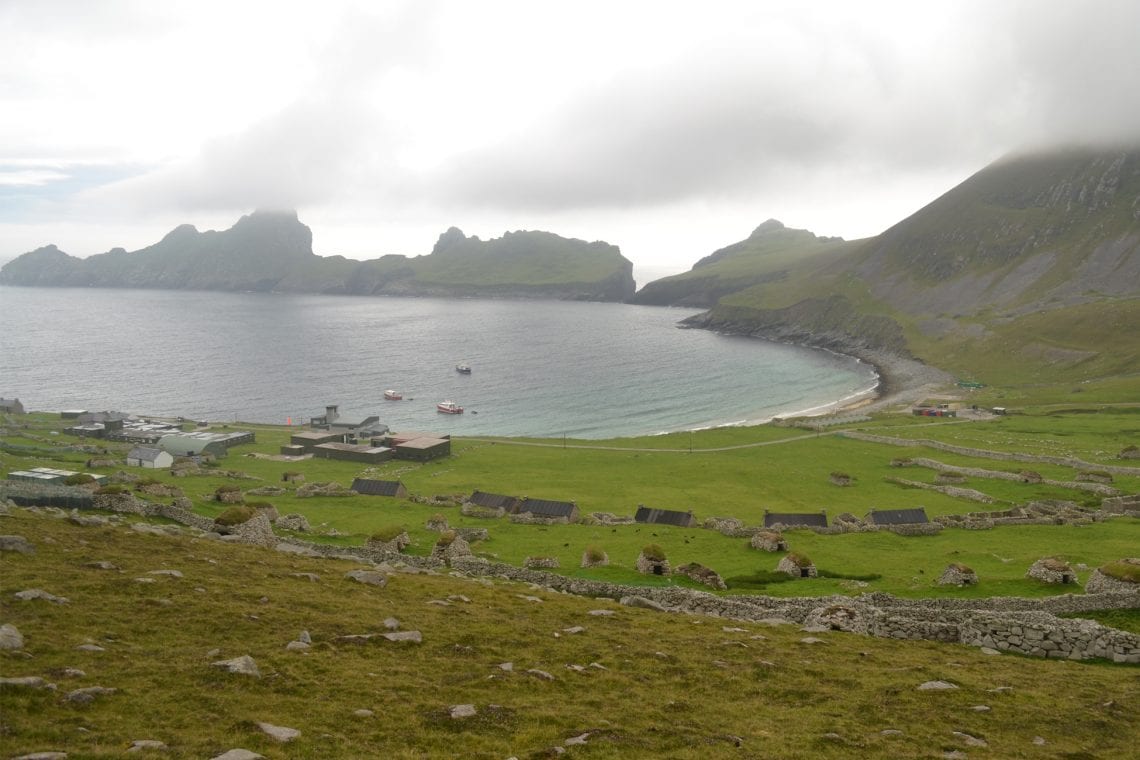
Above: Looking down on Village Bay
I begin to sense a break in the weather. “Typical!” I shout at myself. Hesitantly, I think, ‘is now the time to hike up to the viewpoint again?’ I look past the buildings to the area called The Gap. It’s not as high I was previously but connects to high points and the views should be just as impressive from there should the clouds dissipate. From where I’m standing, the tip of The Gap becomes visible and that’s my sign to make a brisk hike for it. I race up the steep hill past the many cliets dotted around and within fifteen minutes I’m making my final approach. I see the edge of The Gap, just about clear of any cloud cover but within seconds of me reaching my view point the cloud again foils my plans as it swiftly blows in. My pace slows as disappointment seeps in, and then, just as I’m about to plant my right foot on the ground, I suddenly, instinctively jump backward, and simultaneously feel like my heart jumped not just one, but a few hundred beats. Catching my breath, I slowly crawl to where I was about to plant my foot, and I’m gazing out over sheer cliff. I just about make out the ocean below before more cloud works its way in. This is exactly what the warden warned us about. Realising how close I’ve come to simply disappearing off the most remote outpost of the United Kingdom, I sit down for some lunch and reflect on my day, and hope it may still clear up before I head back down. Unfortunately, it doesn’t.
Back in the village I visit the small shop and buy a postcard and the warden kindly promises to send it on my behalf. Then I wander into the nearby chapel where I’m told services are still sometimes held, and on to a nearby artillery gun, mounted in World War Two after a German U-boat attack. My fellow visitors have gathered at the jetty awaiting pickup. The day has flown by and I’m not at all disappointed anymore about the weather, I tell myself that it’s been more authentic this way, the islanders would have probably had more of this weather than the sunshine I had hoped for.
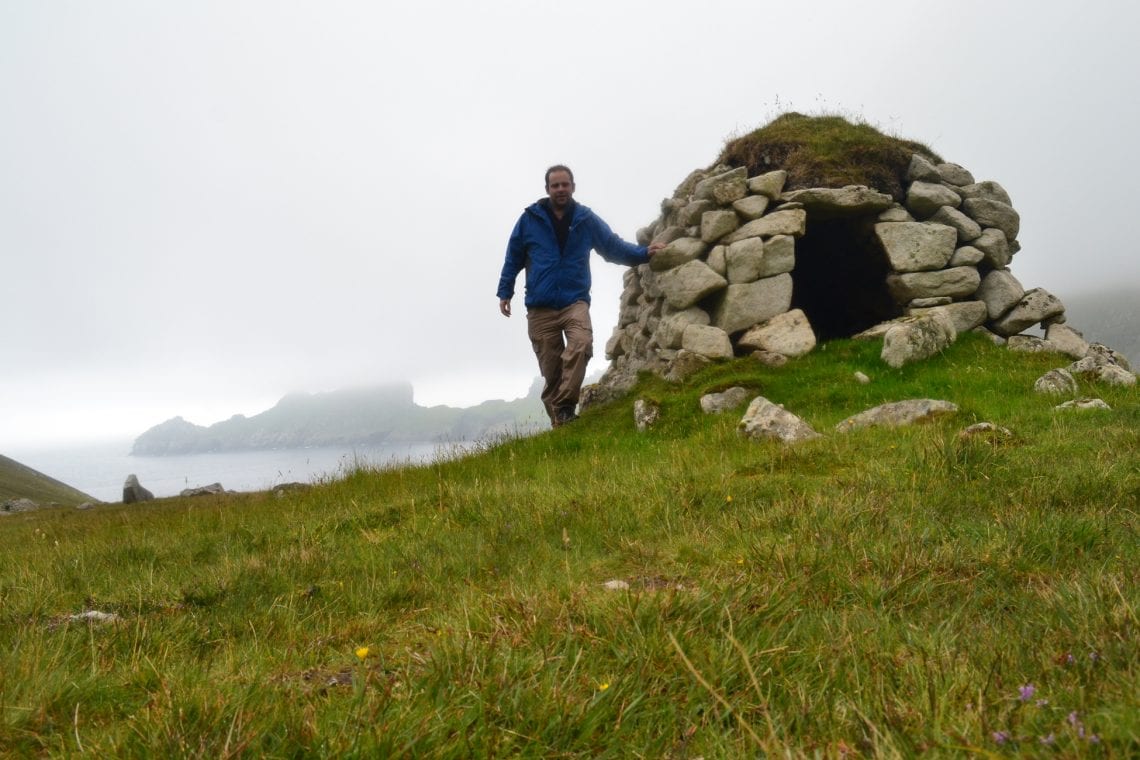
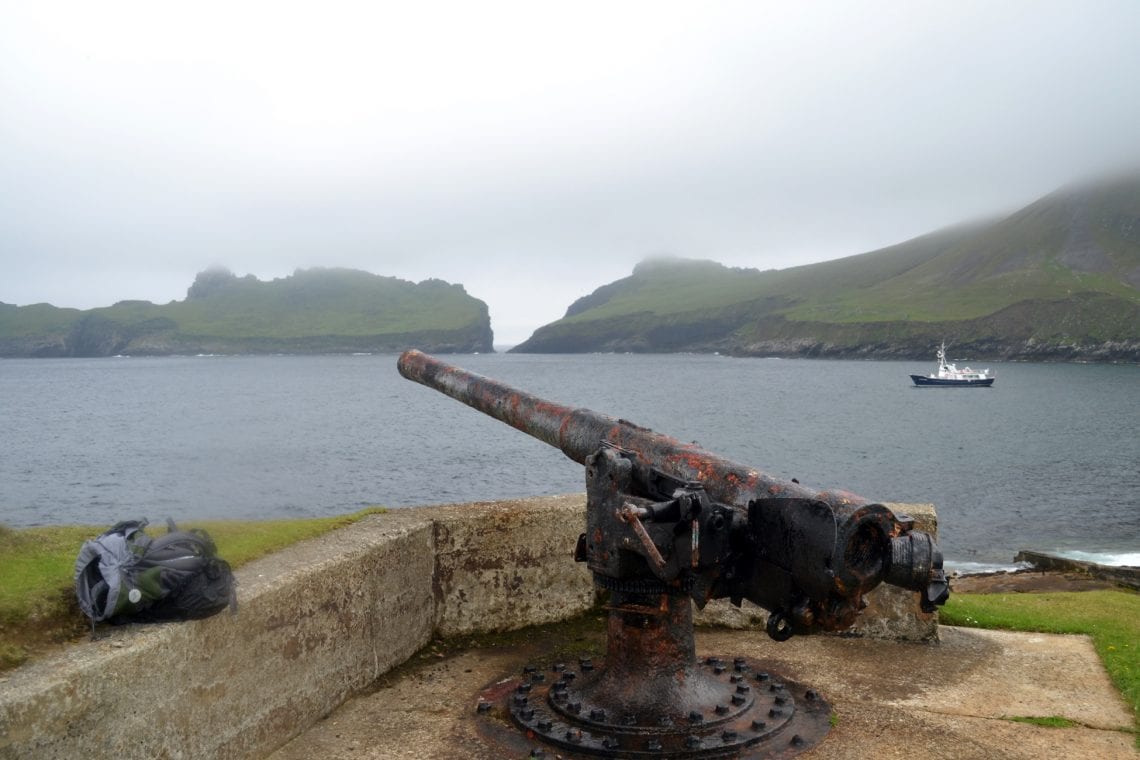
Above: Opps – it’s not hard to just walk of one of the highest cliffs in the United Kingdom | A cleit is a stone storage hut | Artillery gun, mounted in World War Two after a German U-boat attack
Once on-board the Orca III we’re all greeted with a much welcomed cup of tea and some homemade banana cake. It’s not long before Angus brings his engines roaring back to life. Our return trip will take us past some of the steepest cliffs and sea stacks in the UK, and we’ll visit the other islands of the archipelago where some of the most important bird breeding colonies on the planet are situated. In particular, the gannet population here is of major significance. On deck, an elderly gentleman tells me “Now imagine how the islanders felt when they left their homes for the last time,” a sobering thought which stuck with me for much of the return voyage.
The Orca III takes us further seaward for close of views of Stac Lee, Stac An Armin and the island of Boreray. Angus and Murdur explain to us how the islanders used to sail here to these unforgiving cliffs to collect bird eggs and how they’d stay here for weeks at a time. They point out features in the rock, shelters built for and by these brave men for the gatherings. They share their knowledge with great enthusiasm, and it’s obvious to me that these two love what they do.
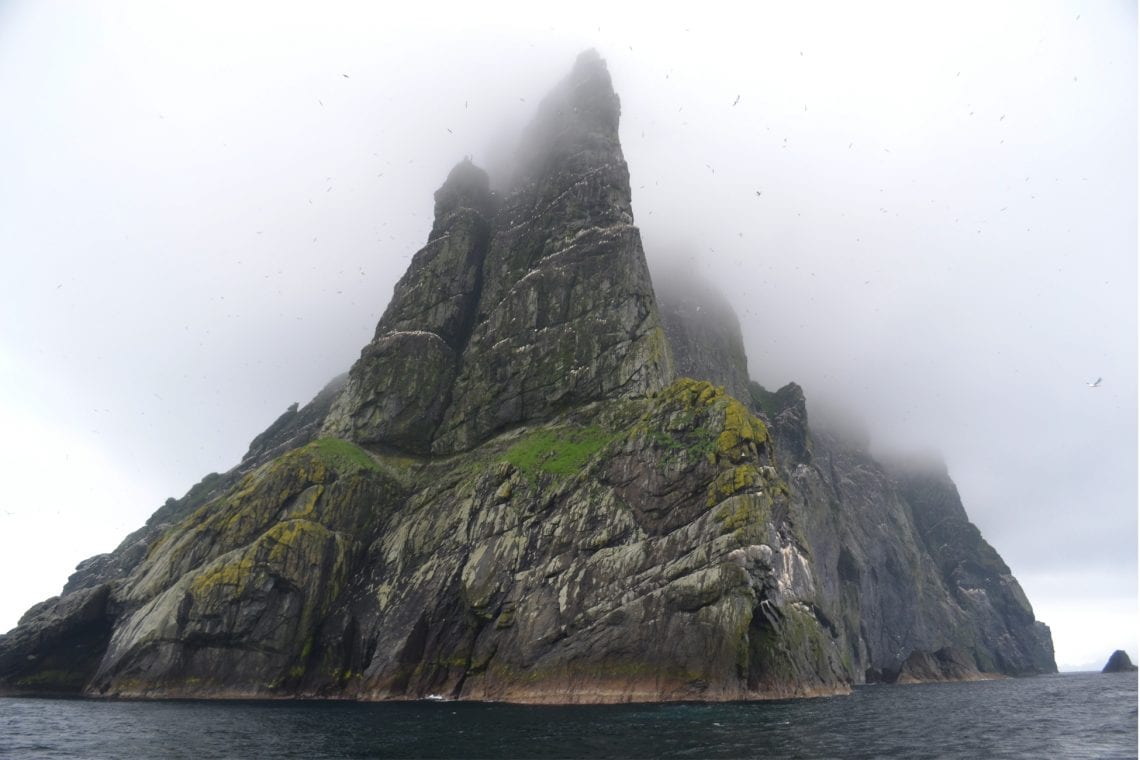
Above: These massive cliffs are home to some of the most important bird populations – they all smell pretty bad
The boat is piloted close to these cliffs to give us a true sense of how enormous these monoliths are. High above us are thousands of birds, flying, diving and nesting. The dark cliffs are lined with white guano, the noise from these sea birds is loud, and the smell is strong. I was later told that they eat thousands of tons of fish a week, which in turn means they produce thousands of tons of guano a week, with no one to clear it up! Angus pilots the Orca III around the tall stacks: for perspective, these sheer cliff faces are substantially higher than the tower which houses Big Ben. The tour comes to an end as we head into open waters once again for the trip back to the small harbour in Leverbrough. It’s been a long day and opposite me a fellow passenger looks to be turning a bit green as the rocking of the boat puts me to sleep. The final moments of our time on board are marked with a complimentary whisky poured by Murdur, here the weather has lifted and the sun’s come out as I sip away. When we all say goodbye to each other at the pier, it feels like saying farewell to old friends. We’ve all shared this magnificent place and it’s clear that everyone enjoyed their day, however they spent it. I wait behind for a lift back to Tarbert but not before having a quick pint with the crew of the Orca III. The conversation revolves around St Kilda, the boats, the sea, fishing and then back to St Kilda. I’m grateful for the chance to visit this amazing place and to share the experience with people who have a real passion for what they do.
WHERE TO STAY
There is a campsite on St Kilda run by the National Trust of Scotland but as it’s on a remote island you will have to plan your visit very carefully. You’ll be likely travelling from Harris which as a variety of accommodation.
- A M Bothan Bunkhouse, Leverburgh (walking distance from the hourbour where Kilda Cruises depart)
- Rock View Bunkhouse, Tarbert
- Hotel Hebrides, Tarbert
USEFUL LINKS
- We recommend booking a tour with Kilda Cruise
- Find out more from the National Trust of Scotland
- Information on ferries to the Outer Hebrides: www.calmac.co.uk
- Bus time table and services on the Outer Hebrides: bus services



